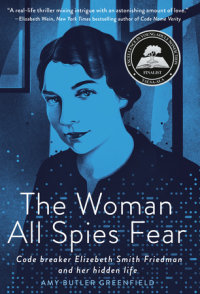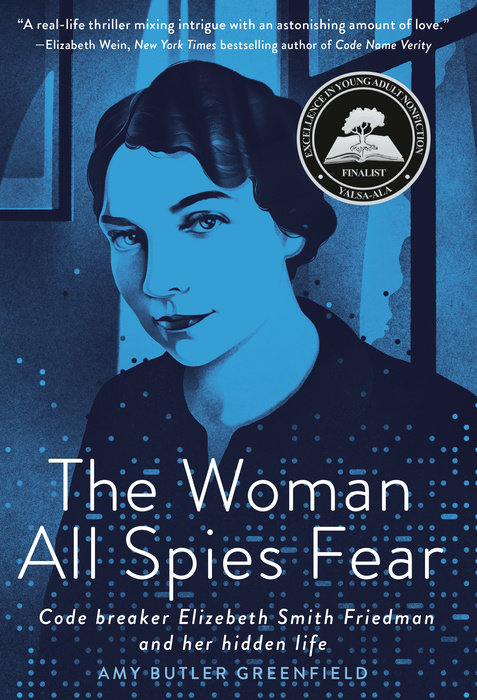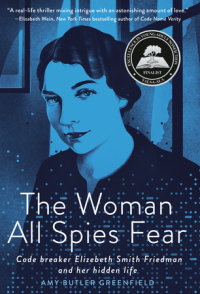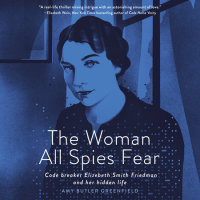The Woman All Spies Fear
An inspiring true story, perfect for fans of Hidden Figures, about an American woman who pioneered codebreaking in WWI and WWII but was only recently recognized for her extraordinary contributions.
A YALSA EXCELLENCE IN NONFICTION FINALIST • A KIRKUS REVIEWS BEST BOOK OF THE YEAR
Elizebeth Smith Friedman had a rare talent for spotting patterns and solving puzzles. These skills led her to become one of the top cryptanalysts in America during both World War I and World War II.
She originally came to code breaking through her love for Shakespeare when she was hired by an eccentric millionaire to prove that Shakespeare's plays had secret messages in them. Within a year, she had learned so much about code breaking that she was a star in the making. She went on to play a major role decoding messages during WWI and WWII and also for the Coast Guard's war against smugglers.
Elizebeth and her husband, William, became the top code-breaking team in the US, and she did it all at a time when most women weren't welcome in the workforce.
Amy Butler Greenfield is an award-winning historian and novelist who aims to shed light on this female pioneer of the STEM community.
An Excerpt fromThe Woman All Spies Fear
Chapter One
The Doll Shop Spy
In 1942, in the middle of World War II, some strange letters came to the attention of the Federal Bureau of Investigation. They were all addressed to the same person in Argentina, and they all sounded oddly alike, yet they came from four different American women. The letters were about dolls, and they ran like this:
I have been so very busy these days, this is the first time I have been over to Seattle for weeks. I came over today to meet my son who is here from Portland on business and to get my little granddaughters doll repaired. I must tell you this amusing story, the wife of an important business associate gave her an Old German bisque Doll dressed in a Hulu Grass skirt . . .
When the FBI questioned the women who supposedly had sent the letters, the women knew nothing about them. FBI lab experts confirmed that the women’s signatures were excellent forgeries.
Someone knew these women well enough to fake their handwriting. Someone was hiding behind their names. Could it be a spy?
The FBI kept digging for clues. The four women lived in different cities and didn’t know each other, but it turned out they had something in common. All of them were long-distance customers of a doll shop at 718 Madison Avenue in New York City.
The FBI checked out the shop. Filled with pricey dolls in fancy costumes, it didn’t look like the headquarters of a spy ring. The shop’s owner, Velvalee Dickinson, appeared innocent, too. A graduate of Stanford University, she was a fifty-year-old widow who had been in the doll business since 1937. She and her late husband had once been friends with many Japanese officials, but that was before Japan and the United States had gone to war.
The FBI remained leery. They staked out the doll shop, and they examined Dickinson’s bank account and safe-deposit box. In January 1944, after they traced some of her money back to Japanese sources, they arrested her as a spy.
Dickinson fought back. Tiny, dark-haired, and delicate, she screamed and kicked, scratching at the FBI agents like a wildcat. The money had nothing to do with spies, she insisted when they questioned her. It came from her doll business and insurance payouts.
The FBI was worried. While they’d been able to connect Dickinson to the letters, they weren’t sure how to interpret them. The money trail was also murky, with no clear proof of a link to spymasters. Everything was guesswork, which wouldn’t impress anyone when the case went to trial.
One of the lawyers who had to prosecute the case was U.S. attorney Edward Wallace. He had plenty of courtroom experience, and he knew it was time to seek help. He also knew exactly who he wanted to approach--one of America’s top code breakers, Elizebeth Smith Friedman.
Like Dickinson, Elizebeth was also small, dark-haired, and college-educated, but the resemblance ended there. As a young woman, she had played a key role in code breaking during World War I. She later cracked the codes of American mobsters, smashing their crime gangs. Now, in 1944, she had a top-secret job at the Navy.
Wallace believed that if anyone could crack the Doll Woman letters, it was Elizebeth. But when he asked the FBI if he could put her onto the case, the FBI balked. It wasn’t that they doubted her skill. They had worked with her many times before, so they knew just how good she was. As they saw it, the problem was that Elizebeth was too good. They couldn’t stand the thought that the credit for catching Dickinson might go to her, and not to the FBI.
When it came down to it, however, the FBI needed a conviction. After an initial protest, they allowed Wallace to share the Doll Woman letters with Elizebeth. Luckily for them, the Navy wanted her skills to remain secret, so her name had to be kept out of the record. In case documents, she would be called “Confidential Informant T4.”
Although Elizebeth was busy tracking Nazi spies, she made time to look at the Doll Woman letters. At first, she was given very little background to go on, but even so, she made progress. Soon she was startling everyone with her insights.
As she explained to Wallace, the letters were written in what was called “open code.” This meant that ordinary sentences and phrases had been given secret meanings, agreed upon in advance. These phrases were then strung together in ways that made the letter seem more or less natural to a casual reader.
Elizebeth warned Wallace that the precise meaning of this kind of code was hard to prove. There was usually a certain amount of guesswork involved, and that would make the case a challenge to prosecute. Yet her analysis was shrewd and hard-hitting.
Take these sentences, for instance, from a Doll Woman letter dated February 22, 1942:
The only new dolls I have are three lovely Irish dolls. One of these three dolls is an old Fisherman with a Net over his back, another is an old woman with wood on her back and the third is a little boy.
Elizebeth believed that Dickinson was using “doll” to mean “ship.” The different dolls stood for different kinds of vessels. The “old Fisherman with a Net” was probably a minesweeper. The “old woman with wood on her back” might be a ship with a high upper deck. The “little boy” could be a small warship, perhaps a destroyer or torpedo boat.
Elizebeth worked out the likely meaning of many other words, too. When the letters mentioned “family,” they referred to either the Japanese fleet or other agents, depending on context. The “visit of important gentleman’s wife” was probably an “invitation to the Japanese Navy to bomb the harbor.” The phrases “Mr. Shaw” and “back to work” were a warning that the USS Shaw, a damaged destroyer, would soon be ready for action again.
Elizebeth also pinpointed phrases that identified Dickinson as a secret agent. She could tell that Dickinson was a layperson where ships were concerned, and she made smart guesses about where and how Dickinson had obtained her information. Elizebeth even found clues indicating who else might be involved in the spy ring.
After she traveled to New York to get additional case details, she was able to say still more about the letters. Her findings were sent to the FBI, and the prosecution used them to strengthen their case. In August 1944, Dickinson was sentenced to ten years of jail time.
The FBI and the newspapers were quick to proclaim that “the War’s No. 1 Woman Spy” had been put behind bars. Elizebeth was not mentioned.
Elizebeth had mixed feelings about that. For security reasons, she knew she had to stay out of the limelight. If the Nazis ever learned how good she was at code breaking, it would hamper her efforts to bring their spies down. But it annoyed her to see the FBI taking credit for her work.
It wasn’t the first time that Elizebeth had been pushed into the shadows, nor was it the last. On the FBI’s public website, the account of the Doll Woman case still omits any mention of her, even though the need for secrecy is long past. Married to William Friedman, one of the best code breakers of all time, she is often mentioned merely as his wife. Yet as William himself was quick to point out, Elizebeth was brilliant, too.
Like the open code in Dickinson’s letters, Elizebeth could appear ordinary on the surface. Even now, she is easily underestimated. To get her true measure, you must delve deeper, the way a code breaker would, searching for the truth that lies just out of sight.
Elizebeth did not have an easy start in life. Yet she rose to become one of the most formidable code breakers in the world, the scourge of gangsters and spies. How did she do it? Ambition and grit played a part, but she needed opportunity, too.
She found it in a library--and in one of the strangest job offers of the century.
Chapter Two
Starting Out
Elizebeth rarely talked about what her life was like before she became a code breaker. She didn’t save much from those early years, either. Look in her files, and you’ll find only a few papers, a slim diary, and a handful of old photos from that time. It was a chapter of her life that she kept to herself.
To discover who she was when she started out, you have to comb through all the evidence she left behind, and then go hunt for more. A faded few lines on a census form. A remark made in jest. An old house that still stands square to the road. Like scattered bits of code, none of these snippets gives away much on its own. But piece them together, and the real story starts to emerge.
What you see, early on, is that young Elizebeth Smith was determined to be different. Sensitive to the weight and meaning of letters and words, she wanted even her name to set her apart. There was nothing she could do about her surname--the “odious name of Smith,” as she put it in her college diary. Yet she detested that “most meaningless of phrases, ‘plain Miss Smith.’ ” To her mind, it implied that she was “eliminated from any category even approaching anything interesting.”
It must have been a comfort that her first name was unusual, if only in its spelling. Her mother, Sopha Strock Smith, had called her Clara Elizebeth. It was the Elizebeth part that stuck, spelled with an “e” in the middle, rather than with the standard “a.” Family legend had it that Sopha wanted to avoid the nickname Eliza. Perhaps it was also her way of encouraging Elizebeth to stand out from the crowd.
Sopha was Elizebeth’s champion--and Elizebeth certainly needed one. Born on August 26, 1892, she was Sopha’s youngest surviving child, with eight older brothers and sisters. They all lived in a brick house that Elizebeth’s grandfather had built, on the Smith family farm in Union Township, a few miles east of Huntington, Indiana.
Delicate by nature, with wavy brown hair and hazel eyes, Elizebeth was a tiny presence in that huge family. It was a position that frustrated her. Prone to nausea and stomach problems, she remembered her early years as “as one continual period of throwing up.”
Home was a tense place because Elizebeth and her father did not get along. John Marion Smith had served in the Union Army as a teenager, marching with General Sherman in the Civil War. The experience had soured him, but he was widely respected as a veteran and a good farmer. A staunch Republican, he was also elected to local office. By nature, he was a rigid and controlling man, and he did not think much of females. Sopha tried to shield Elizebeth from his temper.
To Elizebeth, Sopha was her “wonderful little Mother”--a smart and curious woman who was interested in everyone. Like Elizebeth, Sopha was small and dark-haired, and she, too, had been the youngest child in her family. Educated at one of the most advanced schools in rural Indiana, she became a teacher. After she married John Smith when she was twenty-four, she centered her life around family and church, yet she often told fond stories about her student days.
Most likely, it was Sopha who spurred Elizebeth to get a good education. She also gave her daughter backbone. “My mother encouraged me to go my own way,” Elizebeth once said. The lesson stayed with her for life.
Elizebeth had a quick mind, and she did well in her studies. At first, she walked to the small Antioch School near the family farm. Later, she and her parents moved into nearby Huntington, where she went to high school. Drawn to words in any language, she took four years of German and five years of Latin. She had a strong voice despite her small frame, and she spoke with “rare force and effectiveness,” winning the class orator prize. At a time when nine out of ten students never even graduated from high school, she was aiming at college.



